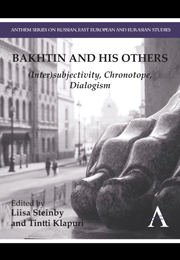Book contents
- Frontmatter
- Contents
- Acknowledgments
- Translation and Transliteration
- Introduction: The Acting Subject of Bakhtin
- Chapter 1 Bakhtin and Lukács: Subjectivity, Signifying Form and Temporality in the Novel
- Chapter 2 Bakhtin, Watt and the Early Eighteenth-Century Novel
- Chapter 3 Concepts of Novelistic Polyphony: Person-Related and Compositional-Thematic
- Chapter 4 Familiar Otherness: Peculiarities of Dialogue in Ezra Pound's Poetics of Inclusion
- Chapter 5 Author and Other in Dialogue: Bakhtinian Polyphony in the Poetry of Peter Reading
- Chapter 6 Tradition and Genre: Thomas Kyd's The Spanish Tragedy
- Chapter 7 Bakhtin's Concept of the Chronotope: The Viewpoint of an Acting Subject
- Chapter 8 The Provincial Chronotope and Modernity in Chekhov's Short Fiction
- List of Contributors
Introduction: The Acting Subject of Bakhtin
Published online by Cambridge University Press: 05 May 2013
- Frontmatter
- Contents
- Acknowledgments
- Translation and Transliteration
- Introduction: The Acting Subject of Bakhtin
- Chapter 1 Bakhtin and Lukács: Subjectivity, Signifying Form and Temporality in the Novel
- Chapter 2 Bakhtin, Watt and the Early Eighteenth-Century Novel
- Chapter 3 Concepts of Novelistic Polyphony: Person-Related and Compositional-Thematic
- Chapter 4 Familiar Otherness: Peculiarities of Dialogue in Ezra Pound's Poetics of Inclusion
- Chapter 5 Author and Other in Dialogue: Bakhtinian Polyphony in the Poetry of Peter Reading
- Chapter 6 Tradition and Genre: Thomas Kyd's The Spanish Tragedy
- Chapter 7 Bakhtin's Concept of the Chronotope: The Viewpoint of an Acting Subject
- Chapter 8 The Provincial Chronotope and Modernity in Chekhov's Short Fiction
- List of Contributors
Summary
The international study of the work of Mikhail Bakhtin has recently witnessed a significant reorientation. Bakhtin was originally introduced in the West, from the 1960s to the 1980s, by two important structuralist theoreticians, Julia Kristeva and Tzvetan Todorov, who represented him as a forerunner of structuralist thinking. In Bakhtin's ‘dialogism’ and ‘polyphony’ they saw forms of intertextuality (Kristeva 1980; Todorov 1984), defined by Kristeva as follows: ‘Any text is constructed as a mosaic of quotations; any text is the absorption and transformation of another. The notion of intertextuality comes to take the place of the notion of intersubjectivity’ (Kristeva 1980, 66). In this interpretation, Bakhtin is placed within a framework of thinking in which the constitutive meaning of the interpretative subject is erased and the subject of narration is ‘reduced to a code, to a nonperson, to an anonymity’ (Kristeva 1980, 74). As an extension of this, it is in the framework of late structuralist discourse pluralism that Bakhtin's concept of ‘dialogism’ has since the 1980s flourished especially in the United States (Holquist 2002). This interpretation of Bakhtin as a textualist is now recognized as an undue ‘familiarization’, occurring in an intellectual atmosphere in which structuralism was dominant (cf. Zbinden 2006).
- Type
- Chapter
- Information
- Bakhtin and his Others(Inter)subjectivity, Chronotope, Dialogism, pp. xi - xxivPublisher: Anthem PressPrint publication year: 2013
- 4
- Cited by



